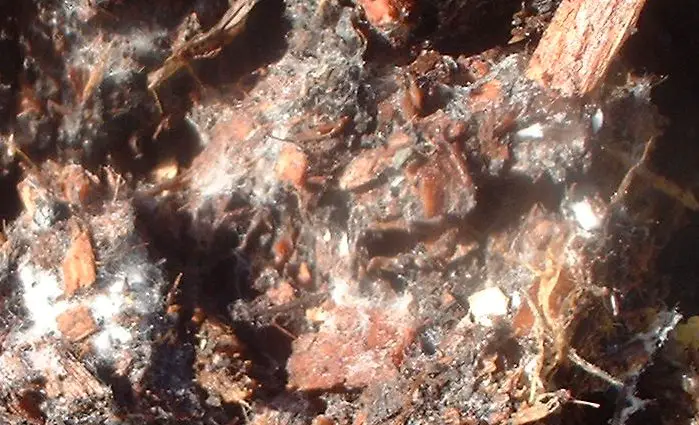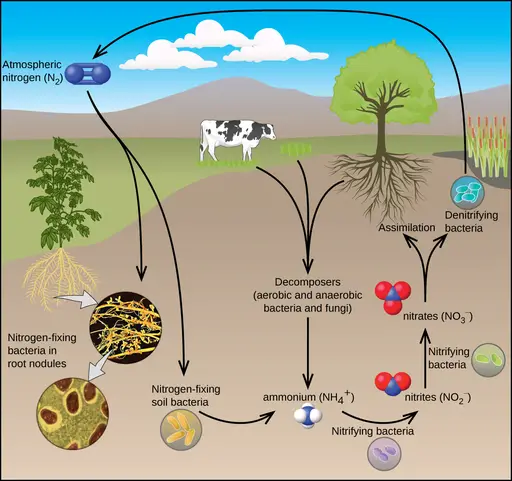Are Bacteria Decomposers?
What is a Decomposer?
Essentially, decomposers include organisms that feed on dead and decaying organic matter of plants and animals, thus further breaking them down. While decomposers use these materials as sources of residual energy, they also help recycle them (organic matter) into forms (e.g. carbon and nitrogen, and other nutrients) that can be used by plants and animals.
In doing so, decomposers also play an important role in preventing different types of organic materials from piling up in the environment. As such, they are an essential part of the ecosystem.
Are Bacteria Decomposers?
Apart from being the most abundant microbes in the soil, bacteria are also common decomposers in nature. Because of their abundance in soil, in both the vegetative and dormant forms, bacteria are involved in the early stages of decomposition.
Some of the bacteria involved in decomposition include members of the Phylum:
How Bacteria break down Organic Material
Unlike some of the other decomposers, bacteria are single-celled organisms. However, they are capable of breaking down various organic materials by secreting different types of enzymes.
In forests, where cellulose and hemicelluloses (as well as lignin and pectin) are some of the main complex carbon compounds (from broken branches and falling leaves etc.), soil bacteria play an important role in breaking them down. Generally, there are different types of bacteria capable of producing different types of enzymes to break down these compounds.
The following are different types of bacteria (and the enzymes they produce) involved in the breakdown of complex material mentioned above:
Streptomyces and Acidothermus - These bacteria produce endocellulase (endo-1, 4-β-glucanase) which breaks down cellulose by cleaving the internal bonds of the structure at amorphous sites.
Thermobifida, Cellulosimicrobium, and Cellulomonas - These are soil bacteria capable of producing exocellulases and xylanase. While exocellulases are also involved in the breakdown of cellulose into smaller sugars, this is achieved through hydrolysis of the chain ends of the structure involving the cleaving of two or more units from the ends of the chain. On the other hand, xylanase breaks down hemicellulose by degrading linear polysaccharide xylan
Actinomycetes, Alpha and Beta Proteobacteria species - These bacteria have been shown to play an important role in the breakdown of lignin (in the form of lignocelluloses). Some of the enzymes produced by these bacteria include lignin peroxidase, Laccase, and catalase
Xanthomonas oryzae - A member of the Phylum proteobacteria, Xanthomonas oryzae produces a variety of enzymes including cellulases, esterases, and xylanases. The production of these enzymes by the bacterium has been associated with blight diseases in rice.
While the enzymes produced by the bacterium are responsible for the breakdown of cellulose and hemicellulose (cellulases and xylanases), some of the enzymes have also been associated with the breakdown of pectin (a heteropolysaccharide found in the primary and middle lamella in plants as well as cell wall of all plants). These include polygalacturonase, pectin methylesterase, and pectate lyases.
* Apart from breaking down polysaccharide complexes in plants, bacteria species like Pseudomonas fluorescent can also produce different types of enzymes (e.g. protease enzymes) responsible for the breakdown of proteins and lipids etc.
In nature, these enzymes contribute to the breakdown of proteins and lipids of dead plants and animals.
Other Types of Decomposers
Fungi
Apart from bacteria, fungi are some of the most common decomposers in nature. Unlike bacteria, fungi are eukaryotic organisms with diversity ranging from single-celled to multicellular species. Like soil bacteria, however, they obtain their nutrition from dead and decaying matter which results in further breakdown of these materials.
Also known as saprotrophic fungi, the majority of fungi depend on non-living (dead) organic matter in their surrounding for nutrients; further breaking them down into components that can be used by plants.
* Some fungi (e.g. Basidiomycetes) can also obtain nutrition from living plants and trees.
Like saprophytic bacteria, saprophytic fungi also produce a wide variety of enzymes that break down cellulose, hemicellulose, pectin, and xylan, etc.
The following are various types of enzymes produced by different fungi and the organic material that they degrade:
Cellulose: Cellulose is an important component of the primary cell wall in many plants. Some of the enzymes used for degrading this complex material include; -1, 4-Endoglucanase, -1, 4-Glucosidase, Cellobiohydrolase, and Cellobiose dehydrogenase.
Some of the fungi capable of producing these enzymes include Trichoderma reesei, Aspergillus phoenicis, Stroptomyces species, and Penicillium echinulatum.
Pectin: Some of the enzymes produced to break down pectin include; Pectin lyase, Pectate lyase, Alpha Rhamnosidae, Endopolygalacturonases, Endorhamnogalacturonase, Endoarabinanase, and -1, 4-Endogalactanase among others. Like cellulose, pectins are diverse in structure. For this reason, various enzymes produced by different types of fungi will degrade this material in their own unique ways.
Whereas enzymes produced by Rhizopus species degrade pectin by acting on the homogalacturonan part of the complex compound, the enzymes that are produced by members of the genus Aspergillus (mold fungi) achieve this by acting on all the elements of the compound through a process known as hydrolysis.
Some examples of other fungi that produce these enzymes include Trichoderma virens and Podospora anserina.
Xylan/hemicelluloses: Some of the enzymes used to degrade Xylan include Xylobiohydrolase, -1, 4-Endoxylanase 3, and -1, 4-Xylosidase. These enzymes have been isolated from a number of yeast species including Candida material and Spathaspora brasiliensis, Trichoderma reesei, Aspergillus species like A. sojae and A. fischeri, as well as Bacillus species, etc.
Like the other enzymes produced by fungi, these enzymes degrade xylan differently. For instance, whereas endoxylase enzymes act by cleaving the glycosidic linkages on the backbone of the structure (to produce oligosaccharides), xylosidase acts slowly on the compound to produce xylose.
Galactomannan: Galactomannans are polysaccharides found in the cell wall of some fungi. Some of the enzymes responsible for degrading this material include -1, 4-Mannosidase, -Arabinofuranosidase, -1, 4-Galactosidase, and -1, 4-Endomannanase.
The enzymes are produced by different types of fungi including Neosarotrya fischeri, Lenzites elegans, and Talaromyces leycettanus among others.
* Like many soil bacteria, fungi are also classified as primary decomposers given that they heavily rely on dead and decaying organic matter for energy (especially in forests and similar habitats). While some species (e.g. yeast) can be found living within plant tissues (especially in plant storage tissue from where they obtain nutrition), the majority of multicellular fungi grow on exposed surfaces of organic matter.
As they grow, they secrete digestive enzymes that are then released to break down various materials making it easier for the organism to absorb the products of the degradation process.
As the hyphae penetrate the substrate (organic matter), more enzymes are secreted as released allowing fungi to access more nutrients as they continue breaking down organic material.
Detritivores
Detritivores, classified as secondary decomposers, include some of the organisms within the kingdom Animalia that survive by feeding on detritus (organic matter of dead plants and animals). Unlike bacteria and fungi, these organisms have a mouth or mouth parts and are therefore capable of feeding on these organic materials.
Some of the most common detritivores (secondary decomposers) include:
Worms
Earthworms are some of the most common animal decomposers. Unlike fungi and bacteria, which are categorized as primary decomposers, earthworms are animals that eat/feed on dead plants and animals rather than releasing enzymes to degrade them externally. However, they also possess a number of important enzymes in their digestive system.
Apart from dead plant and animal material, worms also feed on a number of other materials such as dung (containing partially digested plant material), fungi, and protozoa. As they break down these materials, the end products are mixed with soil thus contributing to soil fertility.
In worms, decomposition of various organic materials starts with the ingestion of tiny materials (organic matter) in their surroundings. These materials are then moved to the gizzard through the esophagus where they are processed by contraction and grinding actions of the organ.
The small, processed pieces are mixed with liquid calcium carbonate before being moved to the intestine where they are acted upon by bacterial enzymes (enzymes are produced by bacteria ingested along with these materials) as well as enzymes of the worm (e.g. Nitrate reductase and alkaline phosphatase) to release the nutrients required for growth and development.
Undigested and partially digested materials (known as the cast) are finally excreted into the environment.
* In areas such as the apple orchards, worms such as Lumbricus terrestris are responsible for the removal of more than 90 percent of leaves that fall during autumn.
* In many farms, worms are used to produce compost. This is because they can digest various organic matter into smaller/simpler pieces (cast) that improve the quality of soil.
Maggots (fly larvae)
Like worms, fly larvae are also considered to be detritivores because they ingest dead organic matter thereby contributing to the decomposition process. Given that maggots start feeding on whatever organic material the eggs were laid on, they accelerate the decomposition process.
Unlike worms, maggots lack a properly developed digestive system. For this reason, they secrete a variety of enzymes (e.g. leucine aminopeptidase, serine proteases, and carboxypeptidases, etc.) allowing them to break down various organic materials and obtain the nutrients they require for growth and development. In doing so, they significantly reduce these materials in the environment.
Arthropods
Some arthropods like crabs and insects like ants are considered decomposers because they feed on various dead organic matter thus further breaking them down. One of the biggest advantages of these organisms is that they feed on a wide variety of organic matter including plants and various animal parts (including other insects).
* While crabs and ants can feed on dead plants and animals, they are not regarded as decomposers in some literature. Rather, they may be classified as scavengers.
Bacteriology as a field of study
Bacterial Transformation, Conjugation
How do Bacteria cause Disease?
Bacteria - Size, Shape and Arrangement - Eubacteria
How do Antibiotics kill Bacteria?
Does Salt Water kill Bacteria?
Which Bacteria cause Food Poisoning?
Return from Are Bacteria Decomposers? to MicroscopeMaster home
References
Alessia Bani et al. (2019). Site-Specific Microbial Decomposer Communities Do Not Imply Faster Decomposition: Results from a Litter Transplantation Experiment.
Grzegorz Janusz et al. (2017). Lignin degradation: microorganisms, enzymes involved, genomes analysis and evolution.
Michel Loreau, Shahid Naeem, and Pablo Inchausti. (2002). Biodiversity and Ecosystem Functioning: Synthesis and Perspectives
Isabelle Benoit et al. (2012). R E S E A R C H A R T I C L E Open AccessDegradation of different pectins by fungi:correlations and contrasts between thepectinolytic enzyme sets identified in genomesand the growth on pectins of different origin.
Links
https://www.the-compost-gardener.com/decomposers.html
Find out how to advertise on MicroscopeMaster!






